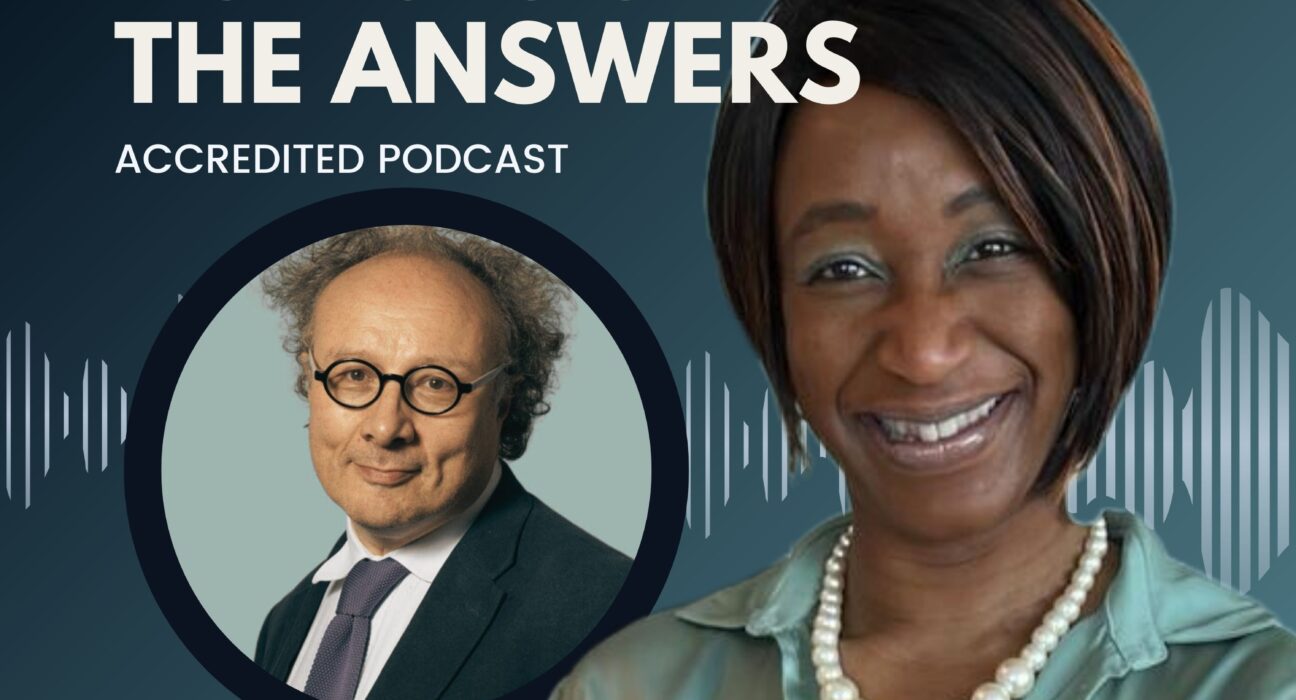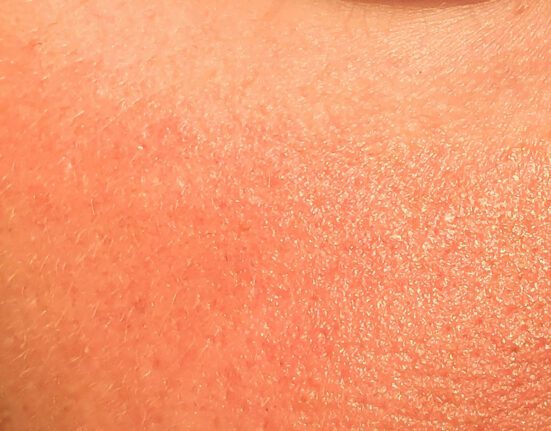
In the first episode of “Long Covid The Answers,” Professor Danny Altmann discusses Long Covid, its definition, prevalence, symptoms, and why it’s serious. He highlights the difficulties in diagnosing and counting cases, the disproportionate impact on women, and the need for understanding various symptom clusters to improve treatment strategies.
Guest – Professor Danny Altmann
Note: This podcast series has been independently produced with no external, industry or commercial input in the creation of it. The podcast has no bias. All conflicts of interest are highlighted with individual guests.
Healthcare Professionals | Earn 0.5 Certified Mainpro+® Credits! Please register/login to claim your CPD/ CEU credits.
Main Podcast Points:
- An interview with Professor Danny Altmann, an immunologist from Imperial College London. The episode focuses on understanding Long Covid based on Professor Altmann’s research and review article “The Immunology of Long Covid” published in Nature Reviews Immunology in July 2023.
- Professor Altmann explains that Long Covid, as defined by the WHO, involves persistent symptoms lasting more than three months after initial Covid-19 infection. These symptoms can vary from mild to severely disabling, affecting people’s ability to return to normal life.
- Long Covid is considered a serious disease, and although the prevalence is difficult to pin down due to underreporting and diagnostic challenges, estimates suggest 10% of pre-vaccination Covid-19 cases and around 4% of post-vaccination cases result in Long Covid. This translates to millions of affected individuals worldwide.
- Long Covid affects anyone who has had Covid-19, but certain groups are more at risk, such as women, who are more prone to autoimmune conditions, and people with pre-existing conditions like asthma or diabetes.
- Symptoms of Long Covid are diverse and include respiratory issues, post-exertional malaise, neurocognitive problems (such as brain fog), gastrointestinal symptoms, and skin rashes. These symptoms often overlap, making it difficult to classify and treat the disease.
- Professor Altmann emphasizes the importance of organizing Long Covid symptoms into phenotypes or groupings to better understand the disease mechanisms and develop targeted treatments. However, he acknowledges the complexity and heterogeneity of Long Covid, with sufferers often experiencing a range of symptoms that can fluctuate over time.
Long Covid involves persistent symptoms lasting more than three months after initial Covid-19 infection. These symptoms can vary from mild to severely disabling, affecting people’s ability to return to normal life.
Dr. Funmi Okunola MD
DISCLAIMER: The information in this podcast is provided for informational purposes only. You should not use any information discussed in this podcast and related materials to make medical or healthcare related decisions. Always consult a your physician or other qualified health care provider with regards to diagnosing managing your medical condition. Any medications or treatments, including any discussed in this podcast, should be initiated and managed by a qualified health care professional.
Podcast Transcript:
Healthcare Professionals: Please note to claim Certified CPD / CEU credits toward your medical license (Canada & reciprocal CPD/CEU Worldwide), you will need to register or log in.
[00:00:00] The information in this podcast is provided for informational purposes only. You should not use any information discussed in this podcast and related materials to make medical or healthcare related decisions. Always consult your physician or other qualified healthcare provider with regards to diagnosing and managing your medical condition. Any medications or treatments, including any discussed in this podcast should be initiated and managed by a qualified healthcare professional.
Funmi Okunola: Welcome to Long Covid The Answers. “What is Long Covid?” is the very first episode of our new series, Long Covid The Answers, the weekly podcast series all about Long Covid. I’d like to introduce Professor Danny Altmann, who will participate in the first of two interviews based on his review article, “The Immunology of Long Covid”, published in Nature Reviews Immunology in July 2023.
Professor Danny [00:01:00] Altman is a Professor of Immunology at Imperial College London in the United Kingdom. His key research interests are the Immunology of Infectious Disease, including severe bacterial infections; he has also worked on autoimmune diseases such as Lupus, Multiple Sclerosis and Rheumatoid Arthritis.
Professor Altmann has been a tireless advocate for Long Haulers and is currently one of the principal leads for the UK’s National Institute of Health’s research study investigating the Immunology of long term effects of SARS-CoV-2. He has also co-written a best-selling book called “The Long Covid Handbook”, which has become a bit of a reference for me and one that I use in clinical practice and recommend to my patients.
Welcome.
Danny Altmann: Thank you.
Funmi Okunola: Danny, do you have any conflicts of interest that you want to declare?
Danny Altmann: Yes. So my conflicts of interest are that, I’ve received, honoraria as a [00:02:00] consultant for, Pfizer vaccines, AstraZeneca vaccines, and Novavax vaccines.
Funmi Okunola: Thank you. If I start with the WHO definition of Long COVID or post COVID condition, it is defined as the continuation or development of new symptoms three months after the initial SARS CoV-2 infection, with these symptoms lasting for at least two months with no other explanation. Danny, in your words, what is Long COVID?
Danny Altmann: Well, I think the definition you just gave is a pretty useful one, isn’t it? So, if I were to give my one minute guide to long COVID, I’d say, yeah, that in the terrors that we all went through early in the pandemic, we all thought about the acute infection, hospitalization, and death and as time has gone by, we’ve become sometimes more blasé about the acute infection; and what’s hitting us more is that many, many people, as you said, in the definition, three months out, aren’t returning [00:03:00] to baseline health and are still having their lives impaired by this whole array of symptoms, that persist, but we can talk about the symptom list in a moment; and, can do anything from making them feel a little bit unwell or under the weather, to really putting them out of work, leaving them housebound, bedbound, severely disabled. So it’s that – it’s the thing that persists for months after your acute COVID infection that, prevents your life returning to what it was.
Funmi Okunola: Thank you. That was really clear.
We are in a time where everyone wants to move on and forget about COVID and the pandemic. Is Long COVID a serious disease?
Danny Altmann: So as you’d expect me to say, I think it’s a terribly serious disease and maybe we’ll continue talking about long COVID long after our kind of short memories have forgotten about the terrors of those first few years of the pandemic [00:04:00] and lockdown.
Because, it’s terribly hard. to count Long COVID cases for all the obvious reasons because we’re bad at counting them, we’re bad at diagnosing them, we don’t necessarily have the will nationally and internationally to count them. We don’t have enough doctor’s appointments to meet face to face to diagnose them. You know, all, the obvious; but we can make some good guesses, can’t we?
So if we say that, certainly from the kind of pre-vaccination era of acute Covid attacks, so if you like the, original, first wave in 2020, and then the alpha wave on planet Earth, if we say that about 10 percent of all of those cases statistically likely have or had long Covid, so that’s, well, you’ll be probably at that stage already up to over 100 million cases on planet Earth, and then people imagine that maybe Long COVID should have gone away once we went into the era where people were vaccinated [00:05:00] or if they did get breakthrough infections they were from so called milder variants like Omicron and sure the risk has gone down. So now I tend instead of thinking about 10% of all cases to think about maybe 4 % of all cases But it’s 4% of a very, very, very, large number.
Yeah, and it’s still an awful lot! So, if I talk about the sort of data in the UK for which we have certainty; we’re pretty sure that of the 1. 9 million cases that we carry in the UK, so 3% of the workforce, about 700, 000 of those cases were accrued during the so called mild, post vaccination Omicron wave.
So that’s kind of my way of saying it’s still a risk. It’s still destroying lives. It’s still with us.
Funmi Okunola: Who gets it and why?
Danny Altmann: So the first kind of high level simple answer is who gets it is anybody who gets infected by the SARS [00:06:00] CoV-2 virus and gets COVID-19. So that’s the first simple high level answer; and above and beyond that you could try and stratify risk groups, couldn’t you? When we talk about those sort of first wave, real, real Long Haulers of the very scary early days of the pandemic, if you think back to those days, the typical, high risk for hospitalization, high risk for death person that we were often talking about was, often male, a bit older, higher body mass index, so the first wave cases, were people a bit like that. They were overrepresented in the deaths, overrepresented in hospitalizations, and therefore overrepresented in first wave, Long COVID sufferers. As time has gone by that kind of, demographic has shifted enormously.
So now when I think about the Long COVID study that we’re doing and the people coming into our clinic, [00:07:00] it looks more like a typical autoimmune disease. In other words, there’s all sorts, but skewed to people who are female, young to middle-aged, so, they’re outnumbering the men at least two to one. If you had to add in other risk factors, you’d maybe talk about people with a history of asthma or diabetes, but really it’s, anybody, but maybe, especially if you are female.
Funmi Okunola: Why do you think females are outnumbering men by two to one in terms of developing Long COVID?
Danny Altmann: Well, you could give a cynical answer, couldn’t you? You could say, well, maybe it’s an artifact of the way that the Long COVID sufferers come to you because women tend to be more, ‘out there’ in terms of discussing and acknowledging their symptoms and being in social media groups to discuss it and things like that. So that would be the almost trivial answer. I’m not a big fan of that as a source [00:08:00] of, if you like ascertainment bias, because coming from a research history in autoimmunity – and I do think this looks a little bit in many ways like an autoimmune disease – in virtually all of those, women tend to outnumber men at least two to one, and that’s not because they’re more likely to spot it.
It’s because, among our gender differences from our different sex hormone programs, are many differences in the way that sex hormones program your immune system; and we have slightly different immune systems. Female sex hormones drive, a slightly more autoimmune program than male ones, among the many, many differences. So that’s my favorite explanation at the moment.
Funmi Okunola: Yeah, that sounds very plausible. I don’t know what you think about this, but I heard an interview, and I can’t remember which Immunologist, or I probably read it, and they said because, women have children our immune systems are much stronger in a sense, so that’s why less women died in the acute phase [00:09:00] of SARS CoV-2 infection, more men died, than women. Yeah, because our immune system is driven to protect the foetus and protect ourselves from the foetus (and so) we’re more susceptible to autoimmune diseases because it’s just, more liable to react in that extreme way.
Danny Altmann: I think, it’s a good and plausible answer that, there’s lots of data coming through on that kind of stuff now. We’ve talked about this for, decades, especially in very, skewed diseases like Lupus or Multiple Sclerosis and COVID and Long COVID have simply reactivated all of those discussions at a time when Immunologists have this amazing toolbox for characterizing their cells, putting (them) through fancy machines and sorters and working out which genes they express and now we’re getting very clear answers about lots of immune system differences between men and women.
Funmi Okunola: Fascinating. What is the prevalence, i. e. the number of people that get Long COVID after acute infection? Why the [00:10:00] controversy around this ranging from 7% of infected people to 60%?
Danny Altmann: So, you the kind of thing I was alluding to, it’s just for all the obvious reasons, it’s hard to count; and, I understand people’s, cynicism and reticence and caution of all things COVID, we’re all so, COVID exhausted and I don’t mean that in a biological sense, I mean that in a psychological sense. Wherever we fall on that kind of political spectrum of libertarian or authoritarian or, COVID skeptic or COVID phobic, we count the number or, we look at the numbers differently, don’t we? So all I try and do as a scientist is, look at the metaanalyses, the analysis of the analysis and say, what does it really look like is happening?
The first thing I’d say is that. The skeptics and the long COVID deniers will try and say, well, [00:11:00] you can’t really trust any of the numbers because lots of the numbers are self-reported and come from things like questionnaires about people’s health.
All I can say to that is that most of the people on planet Earth who’ve had COVID, and certainly most of the people on planet Earth who’ve had Long COVID, haven’t had access to a clinician to do detailed lung function tests or neurocognitive tests and didn’t have the opportunity of having a face-to-face appointment with a doctor to confirm their Long COVID.
I think the Long COVID questionnaires that are routinely used are very detailed and sure, there’s a kind of subjective edge to life isn’t there? Where you get out of bed on a Monday morning, and you think, well, I’m not feeling quite as bright as I was on Saturday morning, and I’m taking those stairs more slower than I did at the weekend and I’m exhausted; but we’re not talking about that. We’re talking about objectively reportable differences in, my God, I can’t stay awake for a working day anymore. I can’t ride my bicycle anymore. I can’t [00:12:00] climb to the top of the stairs without wheezing and puffing and feeling breathless and like I can’t cope! I can’t stand up in the lecture theatre anymore, for a full 45 minute lecture, because I feel like I’m going to collapse! Real deteriorations and changes to people’s health.
So, we bicker about the numbers and how we come to the numbers, but I feel very calm in my estimate. If you take the number as a consensus, middle figure of about 10% from those early, I suppose 2020 cases, before the vaccine age and 4 or 5% from the post vaccine period, you wouldn’t be far wrong.
Funmi Okunola: Right. That’s a great explanation. Can you describe the presentation of this disease, i.e. the diverse range of symptoms?
Danny Altmann: Yeah, so, the first paper that, I think I saw that really attempted to do a [00:13:00] comprehensive analysis of this was the one that, some sufferers actually put together at University College London, where the lead author was Hannah Davis and they did an international survey of Long COVID sufferers in the fairly early days and came up with a really complex, combination of thousands of symptoms, but whittled down to a number of clusters of symptoms that develop over time, sometimes in relapsing and remitting patterns, where, different people have different combinations. A common type of Long COVID sufferer has, respiratory problems and breathlessness and wheeze, perhaps sometimes combined with chest pain. They may also feel like they have very extreme post exertional malaise, a bit like an ME/CFS sufferer and there’s some overlap between people who have those kinds of symptoms and may [00:14:00] also have neurocognitive features, so they may simply feel neurocognitively slower(have) word finding difficulties, brain fog, impaired sleep.
Then there’s some overlap with those first two groups and the people who’ve got a lot of, gastrointestinal symptoms and, gut inflammatory disease and diarrhoea.
Then there are other groups where it looks more like an allergic ] disease, oh you know, allergies, skin rashes, blisters and skin discoloration.
So, you can see I’m going on and on here because the struggle for Long COVID researchers has been to make sense of this because I’ve got no idea whether a first wave person who’s now suffering brain fog has precisely the same disease and the same mechanism as a child from the Omicron period who’s now got diarrhoea and vomiting! Perhaps they [00:15:00] did perhaps they’re not the same thing at all. So, we’re trying to do all this clustering and stratifying intelligently to make sense of it.
Funmi Okunola: I think you’ve partially answered this, but maybe go into it a bit more. Can you please explain why it’s important that the disease is organized into phenotypes or groupings?
Danny Altmann: Yeah, I, think it’s terribly important. In all of modern medicine we’re always trying to sort out, how we going to describe things. Are we going to be, lumpers who’d lump everything together and try and work out common mechanisms and common pathways? Or are we going to be slicers who want to salami slice every single disease into hundreds of different sub- diseases to try and get the best possible answer for personalized medicine?
Obviously, there’s advantages to both approaches, aren’t there? Both seeing the kind of commonalities and seeing the differences. I think there’ve been enough good Long COVID mechanism papers already to know that probably what we’re looking at is a number of different [00:16:00] conditions under the same big umbrella, but it’s not necessarily helpful to lump everything under that umbrella together.
For the reasons that I just said, if you could come up with some sort of meaningful cluster and say, yep, I think that in my cohort, I’ve identified, oh, a thousand people who today, since the COVID say, they’ve got brain fog and didn’t used to have, and I’ve got another thousand people, who say that they feel, like they’ve got a severe respiratory disease and are completely breathless; perhaps I can work out both how those two groups of a thousand people have changed before and after the COVID, but also how they’re different from each other and whether there are different mechanisms? Why should there be the same mechanism that causes, some kind of inflammatory disease in your lungs or poor gas exchange in your lungs or whatever it is, being identical to the thing that makes your brain feel foggy. It might be the same or it might not. It probably isn’t.
Funmi Okunola: I see where you’re coming from, but the challenge [00:17:00] is that if we could have those phenotypes and groupings and we could target treatment and have an idea of how the disease is working in the body, but I seem to find that Long COVID sufferers tend to have a range of those symptoms. So maybe one predominates, but then they’ll say, but I get skin rashes too. I have breathing difficulties and that stops me from getting out of bed, but I get a skin rash every couple of weeks.
Danny Altmann: Yeah, no, your point is really well made and well taken, because, it’s complex and heterogeneous and almost no two Long COVID sufferers are the same out of this enormous list of possible symptoms.
So I suppose what we’re both talking about is the kind of disconnect between academic medicine perfectionism and me wanting to find, the cytokine pathway or the T cell pathway or whatever, that means that you’re going to have, word finding difficulties or gastrointestinal, symptoms or whatever it is that would enable you to pin it down and design the perfect treatment compared to the [00:18:00] real life operational on the ground requirements of general doctors around the world saying, ‘well, your fantasy immunology is all very well, but I need to be able to tick a box or a diagnostic test that I can order, which will say, fairly definitively, does this person or does this person not have a thing called Long COVID? Then I could allocate the appropriate code, put them into the appropriate care pathway, refer them to the appropriate specialist. I could also perhaps work out which therapeutics might work for them!’
Perhaps, just as important at the moment, we’re all so, so desperate to initiate and design and get funding for big clinical trials. Very, very hard for the regulators to get behind us on that, unless they can understand who’s included, why they’re included, how we decided they were included, and how we’re going to know or measure when they’ve got better.
Funmi Okunola: Yeah, I see the [00:19:00] limitations. Long COVID is caused by an infection, by one virus, SARS CoV-2. Can you please explain why yourself and other scientific colleagues believe that this disease will be separated into two or three more separate entities that may have different disease causing paths?
Danny Altmann: I think the jury’s out at the moment, about mechanism, there have been, so many really good studies already about, different possible mechanisms that are only partially overlapping.
So, if I talk about the severe hospitalized first wave people. There’ve been a lot of great studies on those. One in the UK called, PHOSP- COVID – for post hospitalized COVID, that we were peripherally involved with where they scooped up and recruited all of the first wavers hospitalized in the UK and just tracked them for the first year to see how they got on and what became of them and did tons of clinical and laboratory measurements on them. One [00:20:00] of the things we know is that the virus gets into any cell in your body that has the right receptor on it, the ACE2 receptor. They’re in many parts of your body, not just in your nose and in your lungs, but, in your heart, your kidneys, your gut, you name it! So the virus can get into many parts of your body, and cause damage of the kind that could be seen, on MRI. So, just straight old fashioned, organ damage! Every study that’s looked for that has to a greater or lesser extent found it, particularly in severe hospitalized cases. So, you could have one answer that says, well, perhaps that’s a mechanism for some of it – this is simply organ damage.
But some people don’t have organ damage on MRI, some people have clotting abnormalities and a kind of hypercoagulation clotting state which is probably why having COVID is associated with things like, increased risk of strokes. So there’s a whole other group like [00:21:00] that.
Then there’s a whole other group that have new allergic responses, where you invoke an immunological answer. So, you can see what I’m getting at, that all of these kind of symptom groups and symptom clusters and things have led to mechanistic studies, that have invoked different, not mutually exclusive, but different pathways.
Funmi Okunola: I heard, Amy Proal, speak recently. She’s fantastic! She’s a researcher. We’re going to be interviewing her later. She seems to be quite taken on the belief that viral persistence plays a significant role and that it ties in all of the other hypotheses that could be causing a Long COVID together. What’s your take on that? There’s evidence that the virus persists in, because of the ACE2 receptors, presumably multiple different organs. So if the virus is there in some form of low level, activated, sense, it would explain the clotting, it would explain, the autoimmune because it’s there and the cells can recognize that it’s there; the T cells and B cells.
Danny Altmann: Yeah, well, [00:22:00] let me do a couple of minutes on what I think about the viral persistence argument. The first thing to say is that there’s some good evidence for it. Second thing to say is, like everything else about this pandemic, it’s been a real shocker!
Yeah, because, we thought we understood about coronaviruses, the nearest cousins of the kind of common human coronaviruses were the most common – common cold viruses. We don’t think of those as very fancy viruses that hang around in your body and cause persistence. We think of them as in and out kind of viruses.
So It’s been a real shocker to us, I think, to realize how little we understood about coronaviruses, and the idea that they could cause persistence. I became a real convert to the persistence idea when I saw studies from, gastroenterologists, who obviously have to endoscope people and take out bits of gut, and some clever, people like that trying to see if there’s any correlation between people having COVID, SARS CoV-2 virus in their guts and having Long COVID symptoms [00:23:00] and found a very good correlation.
So, it’s not to say the gut is the only place where it could persist, but it looks like a good candidate. So I, really buy into that idea. Also, a number of very fancy papers recently – as Amy was saying to you – saying that there are a number of downstream consequences of having SARS CoV-2 in your gut, including, impaired uptake of some dietary components, like tryptophan, which have lots of downstream consequences for your coagulation, for your serotonin production, things like that. So yeah, lots of pathways that would work, but if I sound like I’m building up to a sort of, ‘but’ – my reticence is that I don’t know if it explains all cases, or how it’s working.
To my mind, if any or most of us who’ve had COVID-19 had persistent virus hanging on there, I’d expect to see [00:24:00] some sort of immunological imprint of it. You know, if I was leaking bits of virus into my gut, I’d expect to see a growing, developing antibody response, a growing, developing T cell response, because it stimulates the immune system.
We’ve looked really hard for that kind of signature in people with long COVID. And we can’t, on the whole, really see it. So, if it’s there, it’s in some sort of covert form that’s immunologically quiet, which is completely possible, but I think there’s more to it than meets the eye.
What I do think about it is that, we’re all trying to think of, how can we help people? How can we actually give somebody some treatment that might actually do some good? It’s stating the obvious to say that if we could reliably identify the people who have persistent virus on board, surely, we could put them into a program of antivirals or [00:25:00] monoclonal antibodies and make them better?
There’s a little, paper doing the rounds recently, which is a case series of three people who were treated with monoclonal antibodies against the virus and completely cured of their long COVID.
Funmi Okunola: Is that the Nancy Klimas study?
Danny Altmann: Yeah, I think so.
Funmi Okunola: Yes.
Danny Altmann: So, there’s ideas out there.
Funmi Okunola: Thank you for that.
COVID 19 was initially presumed to be a respiratory disease. There is now widespread evidence indicating that it is a systemic disease, with viral remnants or active virus being discovered in multiple organs. What do you think is going on with the immune systems of people who have long COVID and this multi- organ infection?
Danny Altmann: I think we shouldn’t, rate ourselves too much, we’ve had a very steep learning curve with this virus and knew nothing about it whatsoever, in, what? December 2019? Inevitably, it was described at the beginning [00:26:00] as being from the common cold family and causing nasopharyngeal and respiratory infections and causing this ghastly hard-to-treat, potentially fatal pneumonia. So, all of our focus was on the respiratory tract, but I don’t think we should be too bothered or surprised that as we’ve learned more about the symptoms and the pathology, we know that you can find it in different places, that it can cause symptoms in different body systems.
We could go on forever, couldn’t we? Reciting lists of viruses that in the end, do things systemically and muck up many different parts of your body. So that, shouldn’t really come as a surprise to us.
Funmi Okunola: We’re now four years into this pandemic with vaccination, infection, reinfection. Can you explain how the different levels of immunity in a population could affect the numbers of people developing Long COVID and its severity or not?
Danny Altmann: Yeah, it’s a [00:27:00] really good and important question. Not least because of the thing I alluded to before that, I think people hoped or imagined that there wouldn’t be any more Long COVID cases and the ones who had it would get better, then we could all forget about it, and that simply by any standards just hasn’t been the case. The simplest and briefest answer I can give is that the best way to not have Long COVID is to not get COVID-19! If your vaccination and your up-to-date boosters prevent you getting infected in the first place, you won’t get Long COVID.
So that’s the simple statement. The simple statement is, carry on with some mitigations, make sure that you take any vaccine you’re offered. Make sure , that you, do whatever you feel are sensible precautions for the level of COVID prevalence out there at any given time.
So, you know, I’m one of those people who still wears a mask on [00:28:00] aeroplanes.
If it was a good restaurant that had outside tables and I had the choice, I’d probably take the outside table on the inside table and that wouldn’t make me a crazy person, that would just make me a sensible person. So , the first simple answer to a question is that we’re in a slightly strange place in terms of our COVID protective immunity.
We’re, in a war of attrition, an arms race against the virus. Perhaps not a place that we expected to be in, in 2024. That is, we’ve had Omicron evolving sub- variants since January 2022. We’ve now got considerable domination by, so called Juno, the JN1 variant of Omicron, and the arms race continues. That is no matter how good we are at vaccinating, designing vaccines, boosting, there’s a moderate level of breakthrough infections of people who get [00:29:00] infected despite having immunity on board.
On the one hand, you could take a glass half full view and say, well, most people, most of the time are getting infected, but it’s not like in the olden days, the proportion of people getting hospitalized or dying is much, much, much, much lower. So, we do have clearly a high degree of effective protection, which has enabled us to get back to normal and and live our lives; but, on the other hand, as I said, those breakthrough infections do come with a risk of Long Covid. We have so many breakthrough infections on the planet now. Even if the rate of Long COVID is now only 4 or 5%, that adds up to a huge number.
Funmi Okunola: I was expecting, like many others, with vaccination, you have a reduced risk of developing Long COVID, so I expected the numbers to go down, but I’ve listened to you on several other podcasts and [00:30:00] the numbers of people with Long COVID have stayed fairly consistent. I’m trying to understand what’s going on in our immune system. It almost seems a contravention. You’d expect the numbers to go down. So, it does that mean some people are getting better, but then they’re replaced by new sick people? What do you think’s going on?
Danny Altmann: I think most of the answer to your question is, complicated maths rather than Immunology. I’m very good at immunology, I’m not very good at maths. So, I’m probably not a good person to ask that question, but if you try and picture that the sort of complex maths I’m referring to.
When I talk about the UK, for example, having been on a kind of plateau of 1. 9 million people with Long COVID, they’re not always the same 1. 9 million people. What happens with Long COVID it is that we’ve got some real Long Haulers who hope and are desperate and have been in that caseload for two or three or four [00:31:00] years now and don’t feel like they’re getting any better.
Then we have people, we all know them who, really suffered from it and knew they had Long COVID and gradually have returned to the swimming pool, have returned to their bicycle, have returned from part-time work to full-time work. So, what I’m talking about is a kind of complex piece of maths where some people are leaving the curve, we don’t even hear about them because they didn’t bother to tell us, they’ve got on with their lives and gone back to normal.
Some people are stuck just unwell and unwell and unwell, meanwhile, all these new cases are being accrued. The kind of people I talked about, even in a time of Omicron, are getting Long COVID.
Funmi Okunola: Yeah, thank you. How are the different SARS CoV-2 variants, Alpha, Delta, Omicron, JN1, affecting the risk of developing Long COVID? Is there any difference?
Danny Altmann: Yeah, so, going back to the last answer, in some ways, it’s a hard [00:32:00] question to answer, isn’t it? Because it’s a moving target in so many ways, isn’t it? Each of the variants has come along at a different point in the timeline, when our immunity has been different. If you were to try and characterize Long Covid from the last few Omicron variants… We certainly try and characterize Long Covid from different variants, and we come up with some differences, some symptom differences, some mechanism differences.
Is that because the virus has become intrinsically different than what it does in your body and how it hangs around? Or is it because we’ve become different because we’re comparing, four – vaccine dose? Three – breakthrough infection people? Two olden days? Zero, one or two vaccine dose people? It’s hard to unpick that because so much changes all the time, but yes, there are certainly differences.
Thank-you Professor Altmann for joining us today. Thanks for all you do and for helping us to learn what Long Covid is.
Funmi Okunola: Some questions for listeners to consider. [00:33:00]
What are your top five takeaways from this episode?
How will this episode change your practice or perception of this disease?
What will you do to act on what you’ve learned?
Please discuss your thoughts on our social media outlets such as Twitter or X, our website blog, Instagram, Facebook, LinkedIn.
Please rate this episode.
SHOW NOTES:
Professor Danny Altmann is a professor of Immunology at Imperial College London in the UK. In this interview, Professor Altmann defines Long COVID.
Research Articles:
1. Altmann DM, Whettlock EM, Liu S, Arachchillage DJ, Boyton RJ. The
immunology of long COVID. Nature Reviews Immunology. 2023
2. Elneima O, McAuley HJ, Leavy OC, Chalmers JD, Horsley A, Ho LP, Marks M,
Poinasamy K, Raman B, Shikotra A, Singapuri A. Cohort profile:
post-hospitalisation COVID-19 (PHOSP-COVID) study. International Journal
of Epidemiology. 2024 Feb 1;53(1):dyad165.
3. Scheppke KA, Pepe PE, Jui J, Crowe RP, Scheppke EK, Klimas NG, Marty AM.
Remission of severe forms of long COVID following monoclonal antibody
(MCA) infusions: A report of signal index cases and call for targeted
research. The American Journal of Emergency Medicine. 2024 Jan








